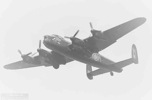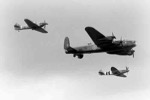170 Squadron
No. 170 Squadron RAF was a Second World War Royal Air Force squadron that operated the North American Mustang in the fighter-reconnaissance role and later the Avro Lancaster as part of Bomber Command.
Motto: "Videre non videri" ("To see (and) not be seen").
Badge: Issuant from a helmet affrontée, the vizor closed, a plume of three ostrich feathers. The helmet with its vizor closed suggests seeing without being seen. The facing position indicates the fact that the squadron "Is always ready to face the enemy". The plume of ostrich feathers of the Guards' colours commemorates the fact that the unit was formed to co-operate with the Guards Armoured Division.
Authority: King George VI, January 1944.
No. 170 Squadron was re-formed on 15 October 1944 at RAF Kelstern from C Flight of 625 Squadron, moving shortly to RAF Dunholme Lodge then again to RAF Hemswell. Equipped with the four-engined Avro Lancaster heavy bomber it was soon operating as part of the Bomber Command offensive over Germany through the winter of 1944/45. As the risk from German fighters grew less it also operated daylight raids. It only operated as a heavy bomber unit for six months but flew 980 sorties with the loss of 13 Lancasters. Following its last raid on 25 April 1945 against Berchtesgaden it concentrated on dropping relief supplies into the Netherlands and transporting prisoners of war and troops back to England from Germany. With its job done it was disbanded on 14 November 1945.
Their Plane

The British Avro Lancaster was one of the most successful heavy bombers of War War II. More than 7,300 were built. It flew 156,318 bombing missions, and dropped a total of 618,000 tons of bombs. It could carry a heavier bomb, and at a higher altitude, than any similar aircraft and was very maneuverable for its large size. Flying a Lancaster was a physically demanding job. The crew flew to an altitude of 21,982 ft. (6,700m) for up to 12 hours. They had to breather oxygen through a face mask often in temperatures as low as 23 degrees F (-5 C). The Lancasters rarely had fighter escorts, and flew mostly at night to avoid being attacked.
(from Aircraft, A stunning visual history of airplanes, by Ian Graham, 2001)




